Lipogenesis in arterial wall and vascular smooth muscular cells: regulation and abnormalities in insulin-resistance
- PMID: 20030821
- PMCID: PMC2805610
- DOI: 10.1186/1475-2840-8-64
Lipogenesis in arterial wall and vascular smooth muscular cells: regulation and abnormalities in insulin-resistance
Abstract
Background: Vascular smooth muscular cells (VSMC) express lipogenic genes. Therefore in situ lipogenesis could provide fatty acids for triglycerides synthesis and cholesterol esterification and contribute to lipid accumulation in arterial wall with aging and during atheroma.
Methods: We investigated expression of lipogenic genes in human and rat arterial walls, its regulation in cultured VSMC and determined if it is modified during insulin-resistance and diabetes, situations with increased risk for atheroma.
Results: Zucker obese (ZO) and diabetic (ZDF) rats accumulated more triglycerides in their aortas than their respective control rats, and this triglycerides content increased with age in ZDF and control rats. However the expression in aortas of lipogenic genes, or of genes involved in fatty acids uptake, was not higher in ZDF and ZO rats and did not increase with age. Expression of lipogenesis-related genes was not increased in human arterial wall (carotid endarterectomy) of diabetic compared to non-diabetic patients. In vitro, glucose and adipogenic medium (ADM) stimulated moderately the expression and activity of lipogenesis in VSMC from control rats. LXR agonists, but not PXR agonist, stimulated also lipogenesis in VSMC but not in arterial wall in vivo. Lipogenic genes expression was lower in VSMC from ZO rats and not stimulated by glucose or ADM.
Conclusion: Lipogenic genes are expressed in arterial wall and VSMC; this expression is stimulated (VSMC) by glucose, ADM and LXR agonists. During insulin-resistance and diabetes, this expression is not increased and resists to the actions of glucose and ADM. It is unlikely that this metabolic pathway contribute to lipid accumulation of arterial wall during insulin-resistance and diabetes and thus to the increased risk of atheroma observed in these situations.
Figures
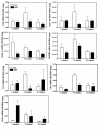
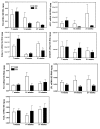



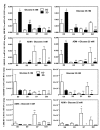
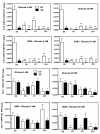
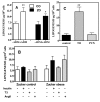
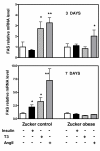
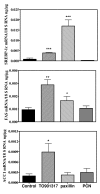

Similar articles
-
Lipogenesis in arterial wall and vascular smooth muscle cells of Psammomys obesus: its regulation and abnormalities in diabetes.Diabetes Metab. 2010 Jun;36(3):221-8. doi: 10.1016/j.diabet.2010.01.003. Epub 2010 Mar 19. Diabetes Metab. 2010. PMID: 20303812
-
Regulation of Vascular Smooth Muscle Cell Dysfunction Under Diabetic Conditions by miR-504.Arterioscler Thromb Vasc Biol. 2016 May;36(5):864-73. doi: 10.1161/ATVBAHA.115.306770. Epub 2016 Mar 3. Arterioscler Thromb Vasc Biol. 2016. PMID: 26941017 Free PMC article.
-
Liver X receptor agonists suppress vascular smooth muscle cell proliferation and inhibit neointima formation in balloon-injured rat carotid arteries.Circ Res. 2004 Dec 10;95(12):e110-23. doi: 10.1161/01.RES.0000150368.56660.4f. Epub 2004 Nov 11. Circ Res. 2004. PMID: 15539633
-
Influence of glucose metabolism on vascular smooth muscle cell proliferation.Vasa. 2013 Jan;42(1):8-16. doi: 10.1024/0301-1526/a000243. Vasa. 2013. PMID: 23385222 Review.
-
Insulin resistance, lipotoxicity, type 2 diabetes and atherosclerosis: the missing links. The Claude Bernard Lecture 2009.Diabetologia. 2010 Jul;53(7):1270-87. doi: 10.1007/s00125-010-1684-1. Epub 2010 Apr 2. Diabetologia. 2010. PMID: 20361178 Free PMC article. Review.
Cited by
-
Pregnane X receptor regulates drug metabolism and transport in the vasculature and protects from oxidative stress.Cardiovasc Res. 2012 Mar 15;93(4):674-81. doi: 10.1093/cvr/cvr330. Epub 2011 Dec 13. Cardiovasc Res. 2012. PMID: 22166712 Free PMC article.
-
Distinct regulation of stearoyl-CoA desaturase 1 gene expression by cis and trans C18:1 fatty acids in human aortic smooth muscle cells.Genes Nutr. 2012 Apr;7(2):209-16. doi: 10.1007/s12263-011-0258-2. Epub 2011 Nov 6. Genes Nutr. 2012. PMID: 22057664 Free PMC article.
References
Publication types
MeSH terms
Substances
LinkOut - more resources
Full Text Sources
Medical

